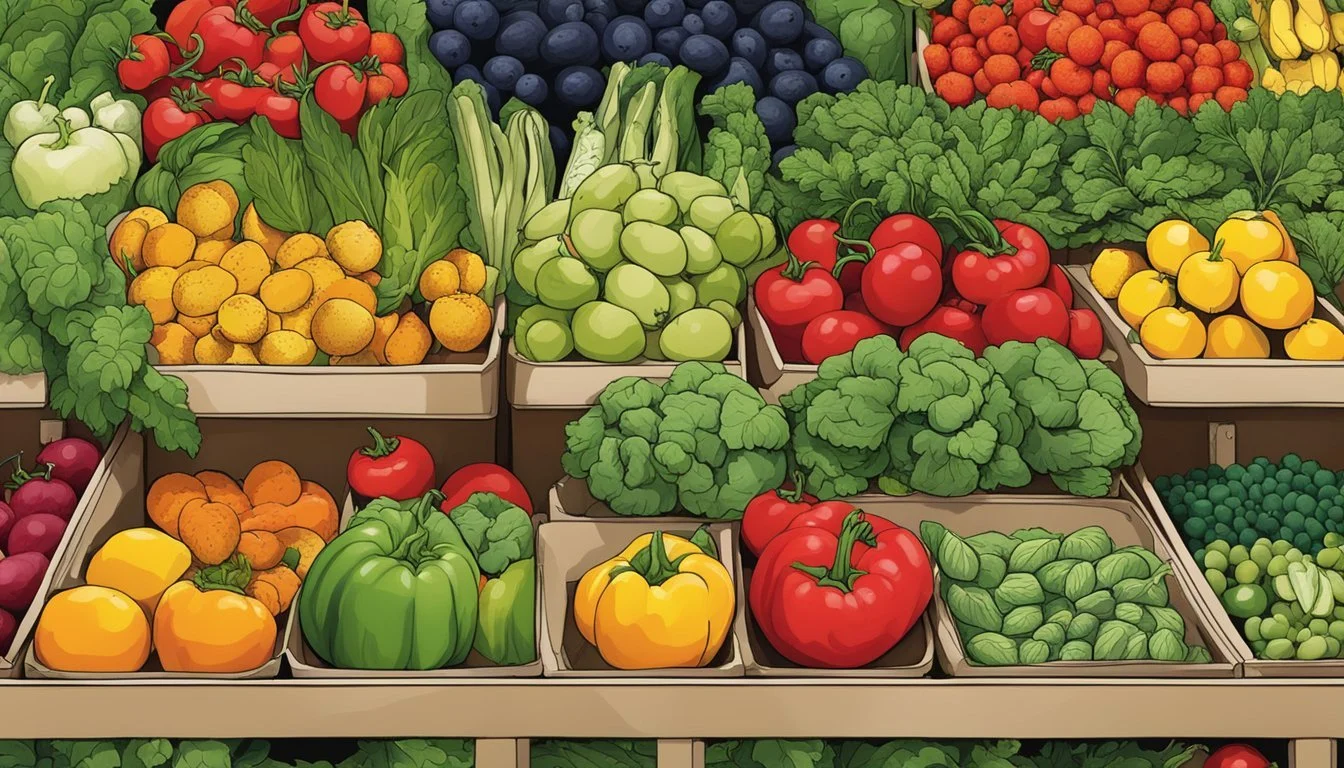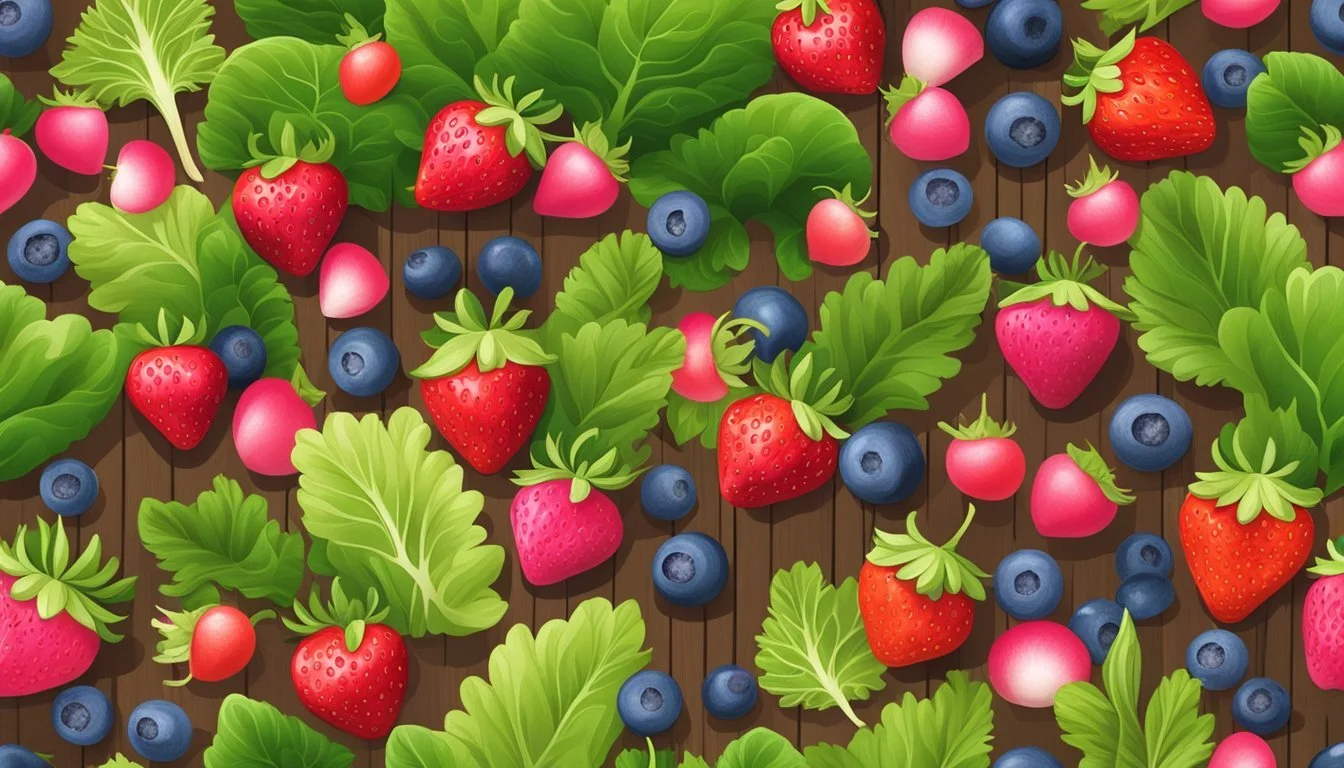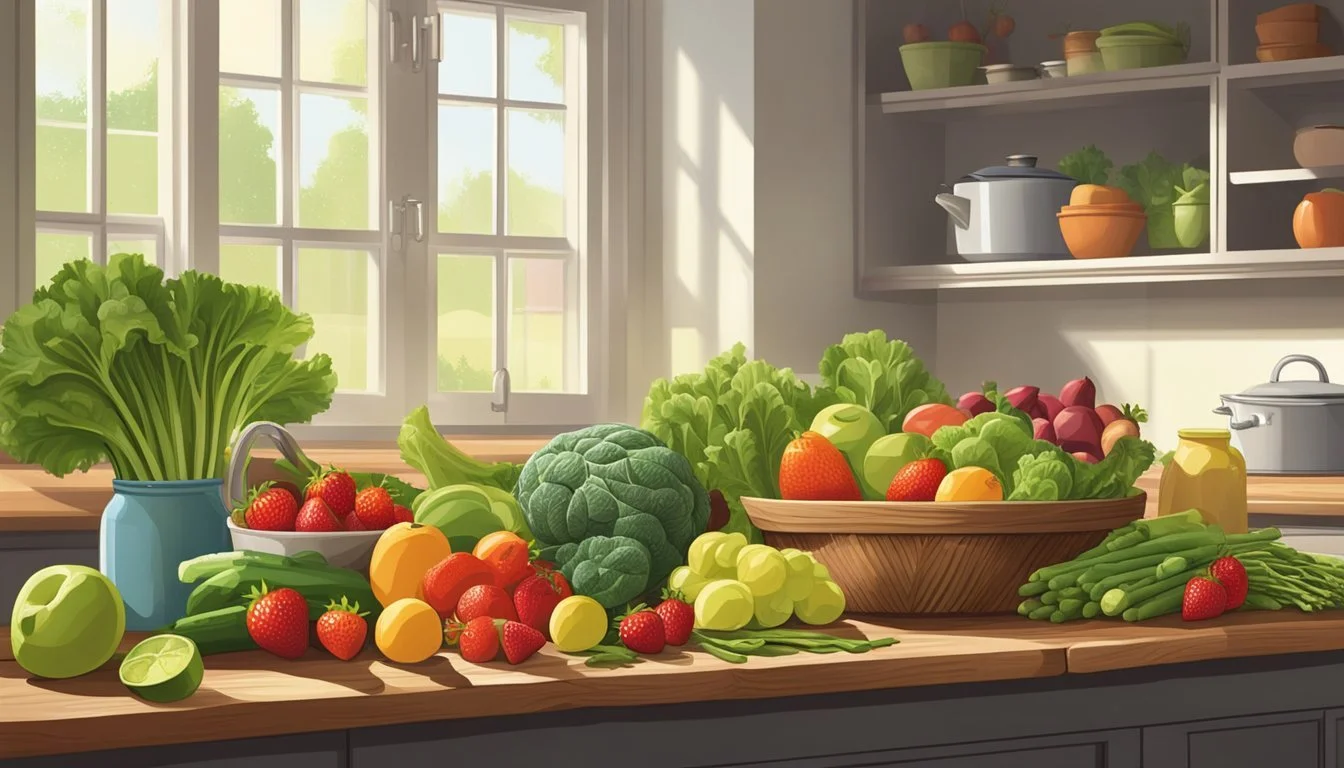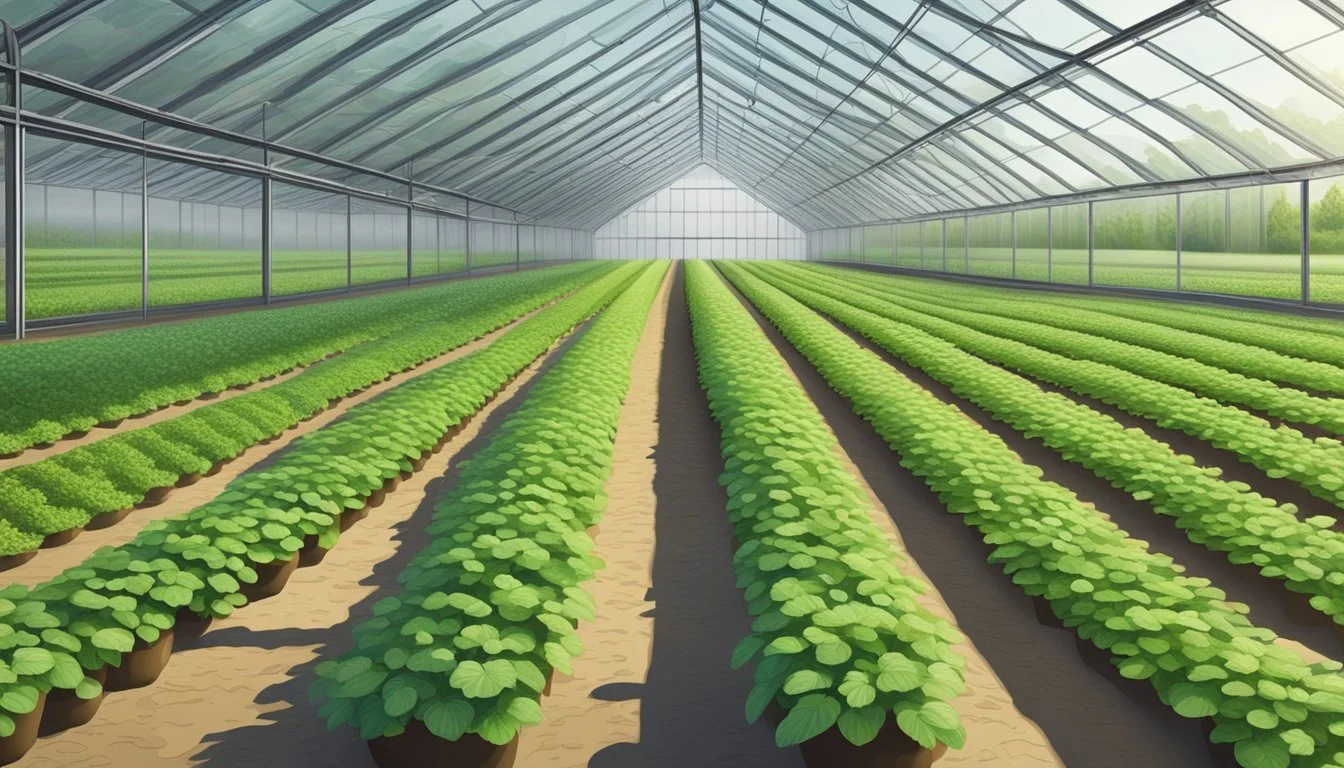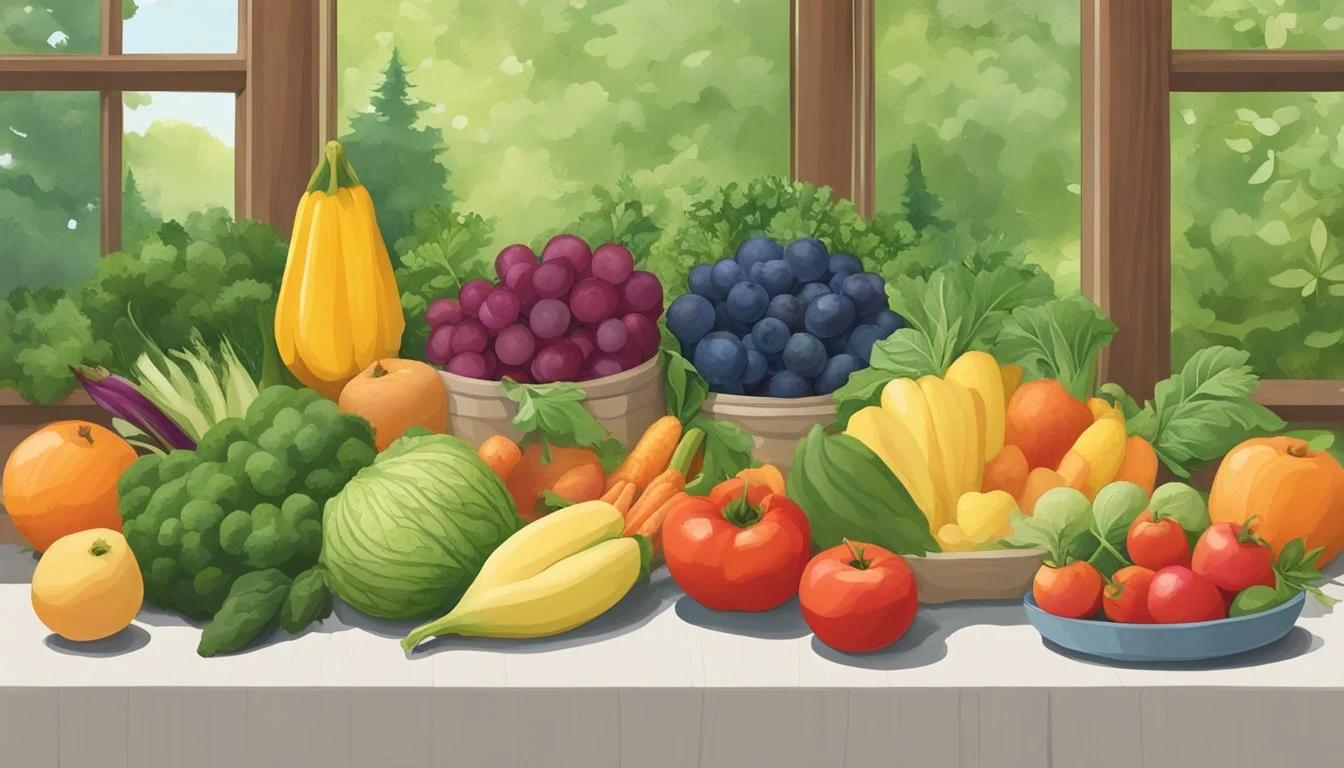Maine Seasonal Fruit & Vegetables in May
Your Fresh Guide
This Article is Part of our Maine Seasonal Fruit & Veg Calendar
As spring reaches its peak in May, Maine offers a cornucopia of fresh, seasonal fruits and vegetables that signal the warming of weather and soil. Agricultural producers across the state take pride in their spring harvests, which arrive with the promise of longer, sun-filled days. In Maine’s farmers' markets and local food co-ops, the selection grows broader with each passing week, reflecting the bounty of the fields and orchards.
Seasonal eating in Maine during May embodies the transition from the earthy root vegetables of winter to the vibrant greens and tender crops of spring. Consumers enjoy a diverse array of produce that includes staples like asparagus (What wine goes well with asparagus?) and radishes as well as regional delicacies such as fiddleheads and rhubarb. This period is also marked by the return of fresh greens, which become more abundant as the month progresses, heralding the approach of summer.
The shift in seasons is not just about a changing landscape; it underlines the importance of sustainable food practices and support for local farmers. Sourcing produce that is in season in Maine during May not only ensures peak flavor and nutritional value but also reduces the environmental impact associated with long-distance transportation of goods. Consequently, May's harvest is eagerly anticipated by those looking to reconnect with the natural growth cycles and savor the freshness that local agriculture has to offer.
Primary Vegetables in Season
May in Maine marks a time when the earth thaws and local farms start to offer an array of fresh vegetables. Various vegetables peak in freshness and flavor.
Leafy Greens and Herbs
May heralds the arrival of several leafy greens, including kale, spinach (What wine goes well with spinach?), and different varieties of lettuce. These greens are known for their nutritional value and versatility in the kitchen.
Kale: Hardy and rich in nutrients.
Spinach: Tender with a slightly sweet flavor when young.
Lettuce: Includes crisp romaine, butterhead, and loose-leaf varieties.
The month is also ripe for culinary and aromatic herbs, with offerings such as parsley, cilantro, and chives (how long do chives last?) enhancing flavors in a myriad of dishes.
Herbs: Fresh and pungent, perfect for garnishes and seasoning.
Root Vegetables
As soil temperatures rise, tender root vegetables begin to make their way to the markets. Farmers harvest a selection of earthy produce, including:
Radishes: Crunchy with a peppery kick.
Beets: Sweet and deep red, ideal for roasting or salads.
Carrots: Crisp and sweet, increasingly popular as young "baby" carrots.
Cultivated Vegetables
By May, cultivated vegetables start appearing as the growing season kicks in. Greenhouses and fields yield fresh vegetables like:
Asparagus: A perennial favorite, signaling the start of the season with its tender stalks.
Scallions: Also known as green onions, add a mild, versatile flavor to dishes.
Cucumbers: (how long do cucumbers last?) Crisp and refreshing, a sign that warmer weather is approaching.
Broccoli: Nutrient-rich and best enjoyed fresh from local gardens.
As warmth permeates the soil, Maine's vegetable offerings expand considerably, providing a bounty for both the palate and the plate.
Primary Fruits in Season
In May, Maine's local farms begin to see the first fruits of their labors with the arrival of certain fresh, seasonal produce. This is a pivotal time for fruit lovers seeking the sweet and tangy flavors grown in the region.
Berries
Strawberries: May marks the beginning of strawberry season in Maine. These berries are known for their vibrant red color and juicy, sweet flavor. Local farms start to harvest strawberries towards the end of May, offering a fresh and locally sourced choice for consumers.
Rhubarb: Technically a vegetable, rhubarb is often culinarily used as a fruit in sweet applications. It's one of the first 'fruits' ready to harvest in May. Characterized by its tartness, rhubarb is commonly used in pies and jams and signals the start of spring's bounty in Maine's produce.
Harvest and Storage Techniques
In May, Maine offers a variety of seasonal fruits and vegetables that require specific harvesting tips and storage solutions to maintain freshness and flavor.
Harvesting Tips
Asparagus: They should be cut just below the soil surface when they reach approximately 6 to 8 inches in height.
Spinach: It is best harvested in the morning when leaves are crisp and moist. One should use scissors to cut leaves two inches from the base to encourage regrowth.
Storage Solutions
Radishes: To store, remove the tops, wash the radishes, and place them in a plastic bag with a few drops of water in the refrigerator to keep them crisp.
Rhubarb: After harvesting, one can wrap rhubarb stalks in plastic and store them in the refrigerator. For longer storage, rhubarb can be chopped and frozen.
Preparation and Usage
This section aims to provide practical methods for preparing and using Maine's seasonal fruits and vegetables available in May. Understanding the best ways to handle and cook these fresh ingredients ensures their natural flavors enhance every meal.
Cooking Tips
When dealing with fresh, seasonal produce such as asparagus, rhubarb, and fiddleheads, gentle cooking methods are often preferred. Steaming or blanching asparagus preserves its vibrant green color and tender texture. It's important to remember that rhubarb leaves are toxic and should never be eaten; only its stalks are cooked, typically in sweet applications due to their tartness. Fiddleheads should be cleaned thoroughly to remove any brown husk and then boiled or steamed to eliminate their natural bitterness.
Asparagus: Wash thoroughly; snap off woody bases. Steam for 3-5 minutes.
Rhubarb: Cut in 1-inch pieces. Cook with sweetener; perfect for pies or compotes.
Fiddleheads: Clean well; boil for 10 minutes or steam for 20 minutes before sautéing.
Recipe Ideas
Utilizing seasonal fruits and vegetables in recipes not only bolsters freshness but also provides a connection to the local environment and its offerings. Salads incorporating greens with slices of strawberries—which make their first appearance in Maine in May—offer a blend of sweet and crisp textures. Vegetables like radishes or spinach can be highlighted in side dishes or added to main courses to bring a touch of spring to the table.
Strawberry Spinach Salad: Combine spinach, fresh strawberries, and a vinaigrette.
Asparagus Quiche: Blend asparagus with eggs and cheese in a flaky pastry crust.
Incorporating these fruits and vegetables in season not only enhances the flavor profile of dishes but also ensures that individuals are getting a taste of the freshest produce available.
Health Benefits
Consuming seasonal fruits and vegetables in May offers a spectrum of health benefits due to their peak nutritional content. These foods are packed with essential vitamins, minerals, and fiber which are pivotal for maintaining good health.
Nutritional Information
Greens, such as spinach, kale, and lettuce, flourish in the month of May in Maine. They are rich in vitamin C, a powerful antioxidant essential for the immune system, skin health, and iron absorption. Equally, greens are often high in fiber, which is beneficial for digestive health.
Berries, though not always in season this early, if found, like strawberries, are beginning to ripen and along with their delightful taste, they give a hearty dose of vitamins and fiber. Fiber aids in regulating blood sugar levels and promotes a feeling of fullness, which can help in weight management.
Here is a table presenting some fruits and vegetables available in May and their associated key nutrients:
Food Item Key Nutrients Spinach High in vitamin C, vitamin A, fiber Kale Rich in vitamin C, vitamin K, calcium Lettuce Good source of vitamin A, vitamin K, folate Strawberries (if available) Rich in vitamin C, manganese, fiber
This variety of fresh produce delivers a range of health benefits, contributing to overall well-being and chronic disease prevention when included as part of a balanced diet.
Buying Local Produce
In May, consumers have the opportunity to support Maine farmers by purchasing local produce that is fresh and in season. These purchases contribute to the local economy and guarantee a selection of produce picked at the peak of its flavor and nutritional value.
Maine Farmers' Markets
Maine farmers' markets are a hub for local, in-season produce. During May, shoppers can expect to find a variety of vegetables such as asparagus, radishes, and spring greens. They can also indulge in the sweetness of seasonal fruits like strawberries. Maine farmers' markets not only boast freshness but also offer the chance to interact directly with the farmers, gaining insights into how the produce is grown.
Community Supported Agriculture (CSA)
Community Supported Agriculture (CSA) programs are a partnership between local farmers and consumers. Participants purchase a "share" of the harvest and, in return, regularly receive a portion of fresh produce throughout the growing season. CSAs help ensure that farmers have a stable income and that consumers have consistent access to seasonal, local produce. May marks the beginning of CSA deliveries for many farms, providing a mix of early season crops to the community.
Season Extension Techniques
Season extension techniques enable gardeners and farmers to cultivate crops beyond the typical growing calendar, effectively expanding the window for local produce availability.
Greenhouses
Greenhouses offer a controlled environment for plant growth where temperature and humidity can be regulated. By utilizing a greenhouse, producers can start cultivating crops in April, ensuring that they are ready for harvest in May, well ahead of the usual outdoor planting schedules. This method is crucial in Maine, where the growing season is relatively short.
Benefits:
Extended Growing Season: Allows for the cultivation of plants before the last frost and after the first frost of the season.
Climate Control: Offers protection from unpredictable weather, pests, and diseases.
Cold Frames
Cold frames are simpler structures that trap heat from the sun to create a microclimate for plants. They are particularly useful for hardening off seedlings in early spring or for extending the life of cold-tolerant vegetables into June and possibly July. Unlike greenhouses, they do not typically have a heat source other than the sun and are therefore cheaper to maintain.
Usage:
Early Seedling Start: Seedlings can be started in cold frames to gain a head start in April.
Late Season Harvest: Cold frames can protect crops and extend harvest into the colder months.
By incorporating these season extension techniques, Maine's growers can effectively enhance the productivity of their gardens and farms, ensuring a continuous supply of fresh produce throughout the seasons.
Month-by-Month Guide
In Maine, the transition from spring to summer brings a shift in available produce. Many items begin their season in May, offering fresh and locally grown options at farmers' markets and local stores.
What's Available in April
As April sets the stage for spring, Mainers find a variety of produce that thrives in the cooler temperatures. The markets typically have:
Apples: Stored from fall harvest and still available.
Root Vegetables: Including beets and carrots, ideal for roasting or adding to salads.
Greens: Some hearty kale and spinach start to become available.
Maple Syrup: (how long does maple syrup last?) A sweet staple of Maine, produced as the sap flows during early spring.
What's Available in May
May ushers in a broader spectrum of fresh produce as the ground thaws and warms:
Fiddleheads: A local delicacy, these coiled ferns emerge in early May.
Rhubarb: Known for its tart flavor, often used in pies and desserts.
Asparagus: Begins its short but sweet season.
Greens: An expansion of kale, spinach, and lettuces is typical.
Culinary Herbs: Such as chives and parsley, start to flourish.
Planning for July
Looking ahead to July, gardeners and shoppers alike anticipate the peak of Maine's summer bounty:
Berries: Strawberries wrap up as blueberries and raspberries prepare for harvest.
Summer Vegetables: Start planting tomatoes, cucumbers, and peppers for a July harvest.
Herbs: Plan to cultivate a variety of herbs that can be harvested well into summer.
Food Preservation
Preserving Maine's abundant May produce allows consumers to enjoy the freshness of spring year-round. Methods such as canning and freezing not only extend the shelf life of fruits and vegetables but also offer opportunities to create a variety of homemade products like jams and salsas.
Canning and Pickling
Canning is a valuable method for preserving fruits and vegetables. High-acid foods such as rhubarb can be made into jams following specific recipes, ensuring a balance of flavor and safety. For example:
Rhubarb Jam Recipe:
4 cups of chopped rhubarb
3 cups of sugar
1 package of powdered fruit pectin (how long does pectin last?)
½ cup of water
Combine ingredients, cook until desired consistency, and process in a water bath canner for the recommended time.
Pickling is another technique popular in Maine, particularly with cucumbers to create crispy refrigerator pickles. The process involves:
Vegetables (e.g., cucumbers)
Vinegar-based brine
Herbs and spices (e.g., dill, garlic)
Vegetables are submerged in the brine and refrigerated for a period, resulting in a tangy, preserved product.
Freezing
Freezing captures the peak ripeness of seasonal produce. Vegetables typically require blanching before freezing to preserve texture and color. Salsa recipes can be adapted for freezing by omitting ingredients like cilantro that do not freeze well.
For fruits, it's often preferable to prepare them as you would for immediate consumption before freezing. This may include pitting, slicing, or crushing. For example, strawberries can be hulled and halved, and then spread on a baking sheet to freeze individually before transferring to a container, ensuring they do not clump together.
Agriculture and Economy
Maine's agricultural sector plays a significant role in its economy, especially during the peak season when a variety of produce reaches maturity. May marks a time when Maine farmers see the fruits of their efforts with a range of local produce reaching the market.
Economic Impact
Maine's economy benefits from the sales of seasonal produce, with May featuring a high demand for local specialties such as fiddleheads and wild greens. Farmers play a critical role in supplying these seasonal offerings, which in turn support local jobs and circulate money within the state. The sale of fruits and vegetables in this month contributes to the agricultural sector's impact on Maine's economy, which is substantial considering the state's reliance on this industry.
Sustainable Farming
Sustainable farming practices are at the heart of Maine's agricultural success, especially as consumers increasingly demand environmentally-friendly produce. Farms in Maine often employ methods that enhance soil health and reduce water use, which are crucial aspects during the May season. These sustainable practices not only support the state's focus on local produce but also contribute to the longevity of Maine's agricultural economy, ensuring that farms continue to thrive season after season.
Educational Resources
In Maine, the educational resources available for seasonal fruit and vegetable awareness in May are focused on hands-on learning and community engagement. Primarily, these resources aim to provide information on local produce and how to make the most of the season's offerings.
Workshops and Events
Maine Cooperative Extension typically offers workshops during the month of May, where individuals can learn about local, in-season crops such as fiddleheads and rhubarb. These workshops emphasize practical skills such as proper harvesting methods, storage, and preparation of seasonal produce.
Workshop Topics Might Include:
Harvesting Techniques for Seasonal Produce
Food Preservation and Storage Solutions
Cooking Demonstrations Featuring May Harvests
Community events like farmers' market tours also play an educational role in showcasing seasonal fruits and vegetables. They often feature booths or presentations by local farmers and food educators.
School Programs
Maine schools frequently integrate discussions about local, seasonal produce into their curriculum during May. This is a prime time for school gardens to begin planting, and many school programs take advantage of this by teaching students how to grow and care for local vegetable varieties.
School Activities May Include:
Planting Seeds for Seasonal Vegetables
Interactive Lessons on the Importance of Local Produce
Tasting Sessions to Introduce Students to Seasonal Flavors
Programs like Farm to School often help in bridging the gap between local agriculture and education, providing both resources and expertise to these initiatives.


